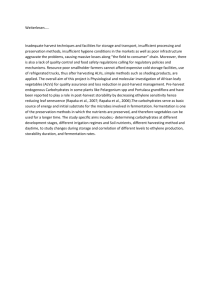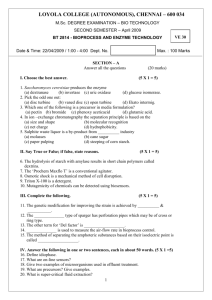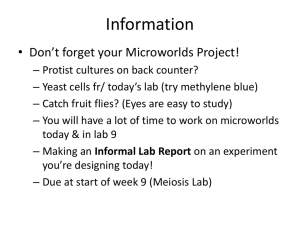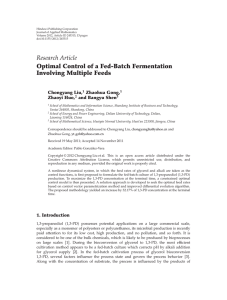Lect. 11: Optimal Control of Fed-Batch Fermentation
advertisement
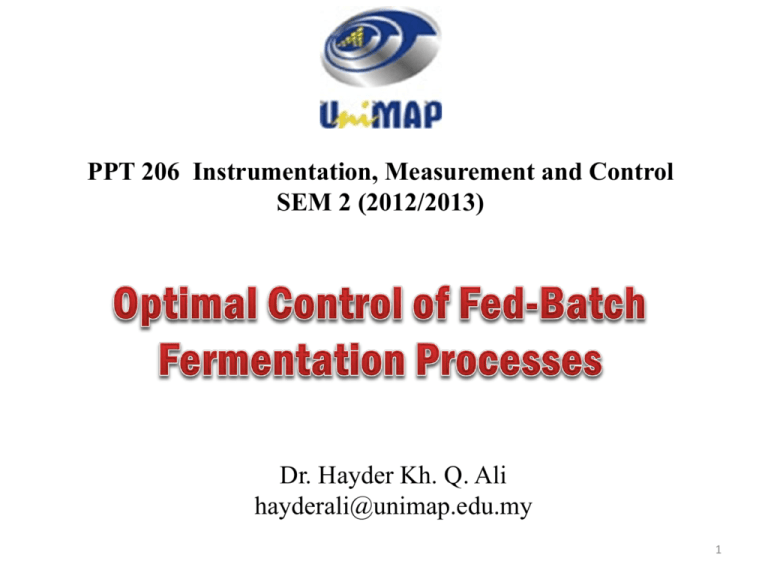
PPT 206 Instrumentation, Measurement and Control SEM 2 (2012/2013) Dr. Hayder Kh. Q. Ali hayderali@unimap.edu.my 1 Theory of fed-batch fermentation Fed-batch fermentation is described in BASIC Biochemical Engineering as the type of system where "nutrient is added when its concentration falls below some set point." Usually the addition is of the nutrient is controlled by a computer for precision. The best way to control the addition of the feed is to monitor the concentration of the nutrient itself in the fermenter or reactor vessel, so you know exactly how much more of it needs to be added. 2 A fed-batch is a biotechnological batch process which is based on feeding of a growth limiting nutrient substrate to a culture. The fed-batch strategy is typically used in bioindustrial processes to reach a high cell density in the bioreactor. Mostly the feed solution is highly concentrated to avoid dilution of the bioreactor. The controlled addition of the nutrient directly affects the growth rate of the culture and helps to avoid overflow metabolism. 3 The nutrient is added in several doses, to ensure that there is not too much of the nutrient present in the fermenter at any time. If too much of a nutrient is present, it may inhibit the growth of the cells. By adding the nutrient a little bit at the time, the reaction can proceed at a high rate of production without getting overloaded. 4 Examples of fed-batch use in industry The use of fed-batch culture by the fermentation industry takes advantage of the fact that the concentration of the limiting substrate may be maintained at a very low level, thus Avoiding repressive effects of high substrate concentration Controlling the organism’s growth rate and consequently controlling the oxygen demand of the fermentation. 5 Saccharomyces cerevisiae is industrially produced using the fed-batch technique so as to maintain the glucose at very low concentrations, maximizing the biomass yield and minimizing the production of ethanol, the chief byproduct. Penicillin production is an example for the use of fedbatch in the production of a secondary metabolite. 6 Hepatitis B surface antigen (HbsAg) used as a vaccine against type B hepatitis has been purified from human plasma and expressed in recombinant yeast, being now produced commercially. Again, the production of the recombinant protein is achieved using fed-batch culture techniques very similar to that developed for Saccharomyces cerevisiae. 7 Advantages and disadvantages of the fedbatch reactors Fed-batch fermentation is a production technique in between batch and continuous fermentation, Fed-batch offers many advantages over batch and continuous cultures: 8 Advantages: production of high cell densities due to extension of working time (particularly important in the production of growth-associated products) controlled conditions in the provision of substrates during the fermentation, particularly regarding the concentration of specific substrates. control over the production of by-products or catabolite repression effects due to limited provision of substrates solely required for product formation 9 allows the replacement of water loss by evaporation alternative mode of operation for fermentations leading with toxic substrates (cells can only metabolize a certain quantity at a time) or low solubility compounds no additional special piece of equipment is required as compared with the batch fermentation mode of operation 10 Disadvantages: it requires previous analysis of the microorganism, its requirements and the understanding of its physiology with the productivity it requires a substantial amount of operator skill for the setup, definition and development of the process in a cyclic fed-batch culture, care should be taken in the design of the process to ensure that toxins do not accumulate to inhibitory levels. 11 Equipment No special piece of equipment is required over the equipment required for batch. However, some considerations should be made over the equipment used for a fed-batch fermentation. 12 1. Vessels The vessels, particularly those used for the acid and base control, must be constructed from a non-toxic, corrosionresistant material which is capable of withstanding repeated sterilization cycles. 13 2. Pumps There are two types of pumps which are suitable for the aseptic pumping of small volumes of culture media: the peristaltic pump and the diaphragm-dosing pump. Other pumps are unsuitable because they are difficult to sterilize and cannot be used for pumping small volumes. 14 Control techniques for fed-batch fermentation Adaptive control is the name given to a control system in which the controller learns about the process by acquiring data from a certain process and keeps on updating a control model. A parameter estimator monitors the process and estimates the process dynamics in terms of the parameters of a previously defined mathematical model of the process. A control design algorithm is then used to generate controller coefficients from those estimates, and a controller sets up the required control signals to the devices controlling the process. 15 An extremely important feature of an adaptive controller is the structure of the model used by the parameter estimator to analyze estimates of process dynamics. Figure 1. describes schematically the concept. 16 Figure 1. Adaptive control: the controller compares the estimates from a mathematical model applied to the system to the readings obtained from the fermentation process. The controller then sends the signal to the device controlling the fermentation, for example, by increasing or decreasing a flow rate 17 The optimal strategy for the fed-batch fermentation of most organisms is to feed the growth-limiting substrate at the same rate that the organism utilizes the substrate, this is, to match the feed rate with demand for the substrate. Four basic approaches have been used in attempts to balance substrate feed with demand (listed in order of increasing accuracy and/or complexity): 18 (i) open-loop control schemes in which feed is added according to historical data or predicted data; (ii) indirect control of substrate feed based on non-feed source parameters such as pH, offgas analysis, dissolved O2 or concentrations of organic products; (iii) indirect control schemes based on mass balance equations, the values of which are calculated from data obtained by sensors; and (iv) direct control schemes based on direct, on-line measurements substrates. 19 Better and more flexible control may be obtained when there is direct measurement of substrate or an excreted metabolite in the medium, which can be used to influence feeding rates to the fermentation. This can be done offline or semi-on-line, but on-line measurements are more useful because of the shorter analysis required, lower personnel requirement and a reduced chance of fermentor contamination. 20 Regardless the type of control, the design is strongly influenced by both mathematical model availabilities and measurement possibilities. 21 Control and optimization of bioreactors is strongly influenced by the quality of the sensors available for crucial response variables. Of primary importance is the ratio of the dynamic parameters of the sensor to those of the process. When these variables cannot be measured easily or quickly enough, a mathematical model must be used in some way in place of feedback information. 22 Algorithms for operating a fed-batch reactor at optimum specific growth rate 23 24


